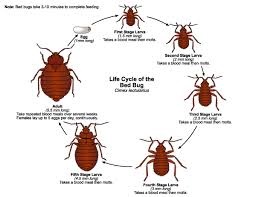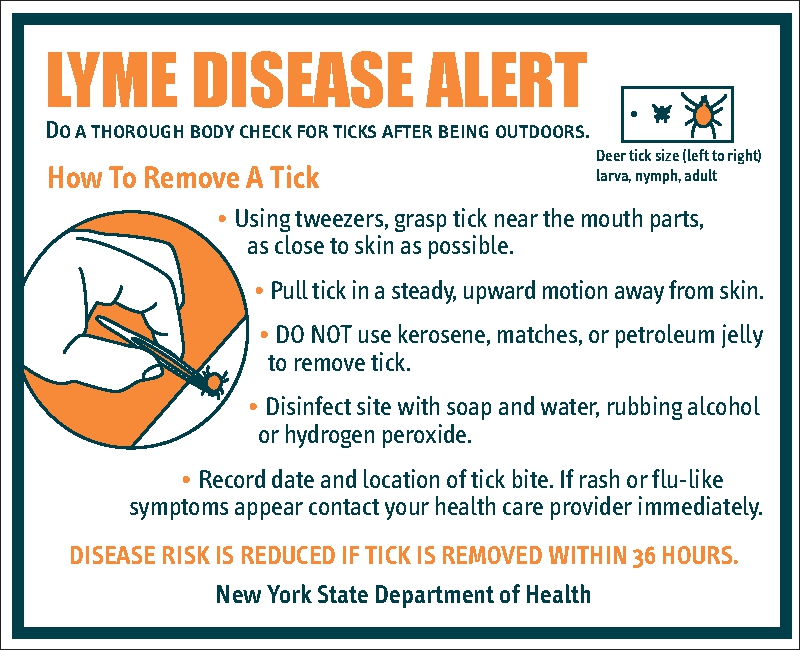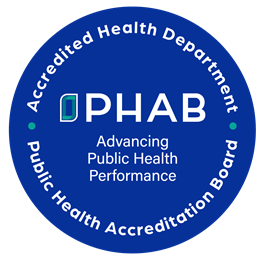Bed Bugs
Diagram of a Bed Bugs Life Cycle
Bed bugs are small blood sucking insects which infest indoor environments. They feed on the people and other warm blooded animals, but are not known to transit any diseases, although they can cause considerable distress to those experiencing problems with them. Unlike many other household pests, bed bugs are not necessarily associated with unsanitary conditions. Anyone can experience bed bug problems in their home regardless of cleanliness.
In recent years, the number of bed bug infestations has been growing steadily and they are becoming common pest across the country (including Cattaraugus County).
Prevention & Control
They are excellent hitchhikers and are often brought into homes with used boxes, luggage and other large objects with places for them to hide. Do NOT pick up furniture off the side of the road if you do not know why it is being discarded. If you do bring home used furniture, make sure that you know the source is bed bug free before you accept it. Transportation of used furniture is a major source of bed bugs in residences.
If you find bed bugs in your home, it is important not to panic. Treatment of bed bug infestations can be very difficult but it is possible. Unfortunately, there is no "silver bullet" treatment for bed bugs. It requires an integrated pest management (IPM) approach. Chemicals and heat treatments can be used to kill the bugs once they are found, but they are capable of hiding nearly anywhere. Active management of the environment by residents is necessary to identify harborage and eliminate hiding places. It is highly recommended that you obtain the services of a certified pest control professional with experience dealing with bed bugs. Infestations cannot be eradicated overnight, it often takes several months of treatment. You must be persistent.
Links
NYS Department of Health - Bed Bugs: What They Are and How to Control Them
Centers for Disease Control & Prevention - Bed Bugs
US Environmental Protection Agency - Bed Bugs
Virginia Department of Agriculture and Consumer Services - Bed Bug Fact Sheets
Cockroaches
Cockroaches are common insects that can become major pests in association with unsanitary conditions. Although there is little evidence that cockroaches can transmit disease directly, there is concern that cockroaches may contaminate unprotected food supplies by transporting harmful bacteria. Many studies have shown that they can also be a significant allergen source in large numbers and be an asthma trigger for susceptible individuals.
Roaches are primarily nocturnal and will seek cover when exposed to light. They are very hardy and capable of feeding on nearly any biological material making them difficult to get rid of once established.
Being highly mobile insects, they will often seek out new food supplies when resources become scarce. It is common to find roaches traveling between apartments through the walls via cracks and unsealed holes around pipes and electrical fixtures. In extreme circumstances, they can even travel between buildings during warm weather months.
Many people will experience an occasional roach in their home in search of new habitats, but most will not develop into an infestation. A study published in the journal "Environmental Health Perspectives" in 2006 indicated that detectable amounts of cockroach allergen were found in 63% of U.S. homes. This allergen was found in homes across all demographics and income levels with the highest rates in urban environments where many people live close together. However, cockroach infestations with higher levels of allergen that would cause adverse reactions were much less common (less than 10% in all cases except high-rise apartment buildings).
Prevention & Control
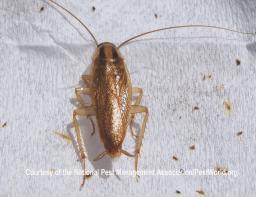
Picture of a German Cockroach
Fortunately for homeowners, cockroach infestations are highly preventable with basic building maintenance and a sanitary household. Sealing cracks and crevices as well as using weather stripping and pipe collars can deny roaches entry into your home. Proper sanitation will prevent any roaches that do enter your home from becoming established and creating a problem. Access to water sources can be limited by fixing water leaks, insulating pipes to prevent condensation and screening aquariums. Timely disposal of garbage, washing of dishes, and routine cleaning reduces food sources. Roaches can also feed on pet food and feces, so limiting the time pet food is left out in dishes and regular cleaning of litter boxes is also necessary.
If you do develop a roach infestation in your home, they can usually be eliminated through diligent sanitation, reducing clutter to limit harborage and baiting. There are a number of easily available products for residential use. Severe infestations may require the services of a certified pest control professional.
For apartment buildings and other commercial buildings, notify your landlord. In multi-unit buildings, roaches will often spread to adjacent units once treatment begins. Building-wide treatment by a certified pest control professional is necessary. Please note that current NYS Department of Environmental Conservation regulations require that all pest abatement in commercial buildings be performed by a certified pest control professional.
Links
NYS Department of Health - Get Rid of Cockroaches
Cornell University Integrated Pest Management Program - Cockroaches
Mosquito Control
In addition to being a seasonal source of annoyance for many Cattaraugus County residents, some mosquitoes can also carry certain diseases which could pose a hazard to public health. Although mosquitoes can transmit various viruses, West Nile Virus and Eastern Equine Encephalitis (EEE) are the two of primary concern in New York State.
Aerial Larvicide Program
For decades, Cattaraugus County, in conjunction with certain towns, has conducted an active mosquito surveillance and control program, which primarily takes place along the Allegheny River Valley in the southern part of the county. However, due to budget restrictions in recent years, the surveillance program is limited and the control program was scaled back.
Please visit our Interactive Mosquito Spraying Map for wetland areas which may receive aerial larvicide application. The most recent legal notice concerning possible larvicide application can be found below:
No recent spraying notices to display
Note that wetland larvicide spraying is different than spraying for adult mosquitoes over residential areas. Cattaraugus County does not do the latter unless a public health threat has been declared.
Reducing Mosquitoes Around Your Home
Regardless of the County's surveillance program, there are some steps you can take to reduce mosquito populations around your home, thereby reducing your risk of exposure to mosquito borne diseases.
Reduce the Population Around Your Home- Mosquitoes require pools of stagnant water to lay their eggs and develop as larvae. Under the right conditions, eggs can hatch and develop into adults in less than four days. By eliminating these breeding pools, you can substantially reduce the populations around your home (see the "Fight the Bite" link below for common sources of breeding pools). Empty or remove all containers in your yard that can hold rainwater. Keep roof gutters clean. Frequently change water in bird baths and kiddie pools. Drain or treat swampy area with larvicide "dunks" available at outdoor and garden stores.
Protect Yourself When Outdoors- Covering your skin by wearing long sleeve shirts, pants, and socks and shoes will prevent most mosquito bites. Use repellents only when necessary and follow all label directions. Apply repellents to your clothing only, not directly to the skin. Avoid being outside during periods of peak mosquito activity (dusk and dawn). Keep screens repaired on all windows and doors.
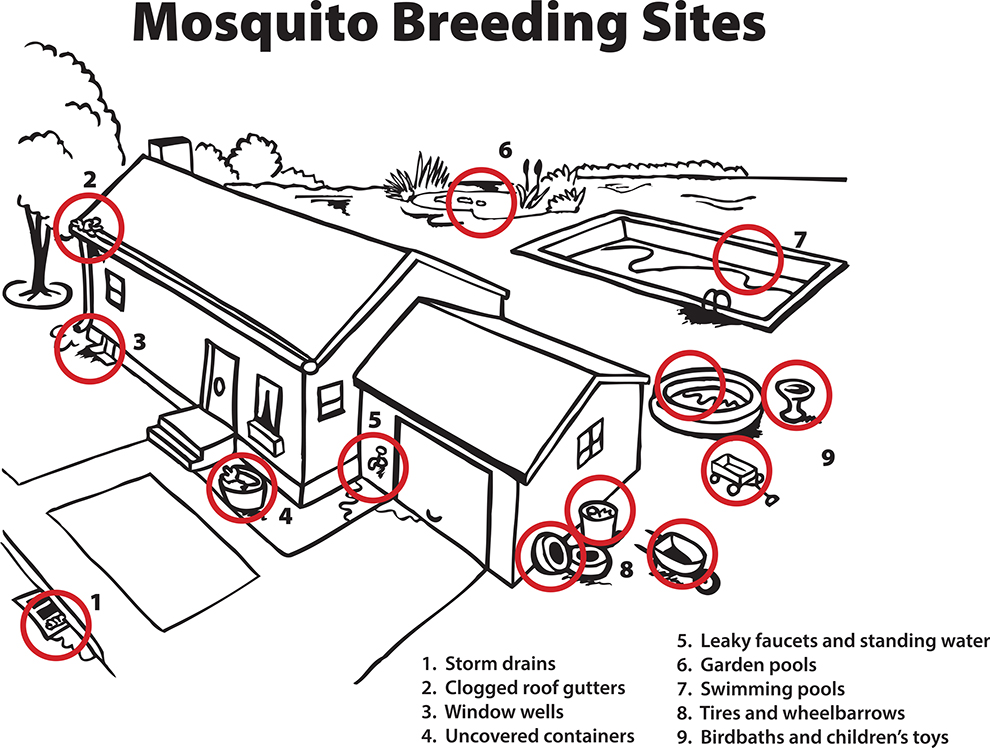
Diagram of Mosquito Breeding Sites
Links
NYS Department of Health - Mosquitoes and Disease
NYS Department of Health - Mosquitoes and West Niles Virus
NYS Department of Health - Eastern Equine Encephalitis
Ticks and Lyme Disease
Picture of Lyme Disease Alert Flier
The NYS Department of Health conducts limited surveys of deer ticks in western New York counties. Captured ticks are tested for the presence of Lyme Disease. Lyme Disease is the most common and most publicized of diseases carried by ticks in NYS. Other tick-borne diseases of concern include babesiosis, ehlrichiosis and Rocky Mountain spotted fever. Each of these diseases are species specific, therefore identification of ticks is important in determining what, if any, medical treatment is necessary if you are bitten.
Beginning in 2009, ticks collected from Cattaraugus and other WNY counties tested positive for the bacteria that causes Lyme Disease. Lyme Disease has been endemic in the eastern part of New York State for many years. However, the presence of this pathogen in this region is relatively new and rates of infection are on the rise. Lyme Disease should be of concern for residents and precautions should be taken to avoid tick bites. See the "Ticks & Lyme Disease" link below for more information.
The Cattaraugus County Laboratory will submit ticks found on humans for identification. This information can be used by you and your physician to determine the possible diseases that may be transmitted. Please note that there is a $15 fee for submission and the results will only indicate the species of tick, not whether or not they carry pathogens.
There are several other private laboratories that will test specific ticks for pathogens (see links below). However, disease transmission is dependent on many factors including species, life stage of the tick and length of time that the tick was attached. The presence of pathogens in the tick does not necessarily mean that those pathogens were transmitted to the person bitten.
Links
NYS Department of Health - Ticks & Lyme Disease

